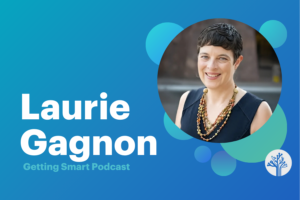5 Emerging Trends in Project-Based Learning

By Rosie Clayton
Over the last six weeks, I’ve been traveling across the U.S. looking at new models of learning and school design, with a particular interest in the move towards deeper and more student-driven learning and models which enable the development of a broad range of skills and competencies in addition to the acquisition of academic knowledge.
Project and inquiry-based learning have been the common thread in most of the schools that I’ve visited, and they are exemplified in a number of different ways. Here are five emerging trends which have pushed my thinking around the design and impact of project-based learning (PBL):
1. Internships
In Big Picture Learning schools, students spend close to 50% of their time during the week off-site, working in industry or the third sector in a range of roles and on a number of different projects. Internships typically last from a number of months up to a full year and allow students to pursue their interests and passions related to future career ambitions.
They develop vital networks and relationships to support/enable progression, gain industry and employability skills and competencies, engage in meaningful and deeper learning activities with specific outputs or products expected (and linked to academic study), and learn from a wide range of adults and highly skilled professionals who mentor, coach and guide.
Internships also drive and frame all learning within the school, and assessment rubrics are co-constructed with educator, community and industry mentors so professional standards and expectations become a foundational part of the school operating systems and culture.
2. Design Thinking
Design thinking has been a key feature of a number of schools and education programs that I’ve visited and is growing in popularity, drawing its inspiration from the product development and lean startup process in the industry. It’s a problem solving based pedagogy where driving questions are framed around addressing a specific human or community need, with an inbuilt bias to action.
The learning process is constructed around making or creating something that will have a direct impact or effect change, and at Nueva School, based in San Mateo, its core elements cover research/deep dive, focus, idea generation, informed decision making, prototyping cycle and collaboration.
Design thinking is embedded through their Innovation Lab and Makerspace, where students undertake Quests and internships as part of elective courses—building and creating a range of tools and products—which cements the pedagogy and facilitates iteration, as well as diffusion and cross-curricular project development across the school.
3.Game-Based Learning
Both digital and physical game-based learning methodologies are also spreading in interest, and Quest To Learn in New York was the first school in the U.S. designed around game-based learning practices. Both in-subject and cross-curricular projects are themed around Quests and Missions, where students work on challenges and solve problems using a game design and system thinking methodology—identify the rules, invent a process, execute and evaluate—and through storytelling and play.
This highly dynamic medium appeals to student interests and instincts, leading to an engaging and motivating learning environment where they take on a variety of real-life roles (enabling authenticity and relevance) and often collaborate with external professionals throughout the learning process (which culminates in an exhibition).
The model enables students to gain a deep understanding of complex systems and concepts and the effect of individual actions and micro processes within them, all while developing a broad range of skills and competencies.
4. Digital Making and Collaborative Maker Cultures
Bergen Tech is part of a CTE campus in Hackensack, New Jersey, which delivers extremely high-level technical education around STEAM, with an on-site makerspace which allows for collaborative project development and delivery across the 6 technical disciplines (business and finance, medical science technology, engineering and design technology, technology and computer science, culinary arts, visual and performing arts).
At Bergen Tech, students work on advanced projects linked to their academic qualifications and chosen career pathways, and with external partners across industry and the third sector, developing products and outputs which may eventually be taken to market. The learning environment is modeled very much on R&D labs in the industry.
Bergen Makerspace provides a physical space as well as the tools for cross-disciplinary work to emerge and develop, and is also accessible to the wider local community, building a culture around making, tinkering, collaborating and experimenting, and entrepreneurship. Success is seen through the lens of student destinations, and across this model vocational education is seen as extremely high value and high status, shifting perceptions about who this type of education is for.
5. Building SEL and Agency
The statistics for Calumet New Tech High School in Gary, Indiana, illustrates the transformative potential of PBL in disadvantaged communities. 90% of students are eligible for free or reduced-cost lunch, yet through a highly sophisticated, mastery-based, 100% wall-to-wall PBL model the school achieves a 96% graduation rate.
Success is measured through growth across five learning outcomes—knowledge & thinking, written communication, oral communication, agency and collaboration—and projects typically run for four weeks through a six stage process. This short project cycle allows students opportunities for presentation up to 15 times per year, as well as continuous analysis and reflection for building mastery.
Two things make this model particularly powerful:
- Instructional time is exactly the same as in any traditional school, and teacher-student ratios are fairly standard (1:30/35), yet accelerated progress and growth are achieved through high productivity and pace, and the effective use and structuring of time—activities are tight and purposeful, and no opportunities for learning are missed.
- Building agency and ownership of learning is absolutely key to the organization’s dynamics and success, and is facilitated by flexible and high-level assessment rubrics which are part of the whole school operating system.
The approaches above share eight important characteristics:
- Success is defined, measured and assessed through multiple frames and forms.
- Assessment is multi-dimensional and holistic, measuring both breadth and depth of capability across a number of metrics, evidenced in multiple forms.
- Learning is authentic, engaging and clearly process-driven towards significant and meaningful outputs and products. Students understand the purpose of learning, and educational experiences relate to real-world and lived experiences.
- Knowledge acquisition and skill development have parity of esteem and blur the lines between academic and vocational learning. Learning by doing is core—and the creation of new knowledge and expertise is highly valued.
- Learning is student-driven and co-constructed with a range of adults and professionals—relationships and power dynamics are based on professional expectations.
- Accountability shifts downwards and the balance between individual and collective accountability enables ownership of learning and the building of agency.
- Time is structured to enable high productivity and accelerated progress.
- Activity is intentionally and proactively outward facing, and there is a strong focus on partnerships and leveraging external expertise and resources, utilizing the wider learning assets across communities.
In all the schools I’ve visited, it’s been exciting to see the ways in which PBL creates connections—within and across the school community as well as external communities—in bringing people and ideas together, creating and developing new knowledge, and connecting ideas and knowledge to action.
There has also been an important balance between individual and collaborative learning and inquiry in each school, with the best balancing the two well—for example, by enabling individuality to be expressed through common activity.
It has also been heartening to see new school models defined by powerful equity shifts which reframe how success and achievement are perceived and measured, what is seen as important and valued, and how individual capabilities are assessed through multiple metrics.
Ultimately, this results in re-orienting the balance of power in learning and accountability for outcomes from a hierarchical top-down approach (government – district – school – SLT – teacher – student+family) to an agency driven horizontal model (student+family – student collective – adults – school community – external & professional community – government) which drives exceptional progress, high level outcomes and personal and community development.
This post was originally published on Buck Institute for Education’s blog.
For more, see:
- Getting Smart Podcast: Two EdLeaders on Global, High-Quality PBL
- Business Partnerships in PBL: What Does That Really Mean
- 8 People who Are Inspiring What’s Possible in PBL
Rosie Clayton is a freelance consultant currently working across education, tech, school and network design in the U.K. She is exploring innovation ecosystems in education across the US as part of a Fellowship with the Winston Churchill Memorial Trust. Follow her on Twitter: @RosieClayton.
Stay in-the-know with all things EdTech and innovations in learning by signing up to receive the weekly Smart Update. This post includes mentions of a Getting Smart partner. For a full list of partners, affiliate organizations and all other disclosures, please see our Partner page.






0 Comments
Leave a Comment
Your email address will not be published. All fields are required.